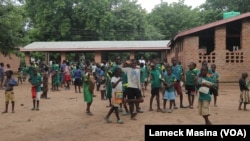
Malawi Launches New Program to Empower Women and Girls
Introduction
Blantyre, Malawi —
Malawi, in collaboration with its development partners, is implementing a new program aimed at lifting the country’s most vulnerable women and girls out of extreme poverty. The three-year program not only seeks to enhance their socio-economic status, but also strengthen their resilience to crises, shocks, and disasters.
Sustainable Development Goals (SDGs)
The program aligns with the Sustainable Development Goals (SDGs), which aim to eradicate poverty, achieve gender equality, and promote sustainable development worldwide.
Extent of Poverty in Malawi
The United Nations Children’s Fund (UNICEF), the European Union, and the Irish government report that over 20% of Malawi’s population of 19.6 million people live in extreme poverty. Furthermore, they highlight that women head over 75% of all families living in poverty, facing violence and harmful practices that hinder their participation in economic activities.
Program Details
The Gender Empowerment and Resilience program is expected to benefit more than 500,000 people in nine districts of Malawi. These districts include Mzimba, Ntcheu, Balaka, Chikwawa, Mulanje, Mwanza, Neno, Nsanje, and Zomba.
Objectives
The program aims to:
- Provide access to social services and cash transfers
- Promote social behavior change
- Improve nutrition
- Enhance early childhood development
- Strengthen sexual reproductive health
- Prevent gender-based violence
Importance of Livelihood Support
Shadrack Omol, UNICEF representative in Malawi, emphasizes the importance of supporting parents and caregivers with livelihoods and resources to ensure the well-being of their children. Through this program, parents will receive assistance in developing the right livelihoods and incomes to support their children’s growth and development.
Investment in the Program
The program is being funded with a budget of $26 million, which will be used to address the challenges faced by Malawian women in accessing economic opportunities and essential social services.
Challenges and Solutions
While the program is welcomed by many, there are concerns about the effectiveness of similar interventions in the past. Eneless Pemba, executive director for Chikondi Girls Project in southern Malawi, highlights the need to consider the specific needs and desires of the beneficiaries. She suggests that interventions should focus on encouraging girls’ entrepreneurship skills, which can provide sustainable income for their families in the long term.
Importance of Cash Transfers
Maggie Kathewera-Banda, executive director of the Women’s Legal Resources Centre, acknowledges that while empowerment programs are valuable, some individuals require additional support to lift themselves out of poverty. Cash transfers offer a starting point for those who are extremely vulnerable and unable to escape poverty on their own.
Creating an Enabling Environment
The European Union Ambassador to Malawi, Rune Skinnebach, and the Irish Ambassador to Malawi, Séamus O’Grady, emphasize that the program will help create an enabling environment for Malawian women and girls to contribute meaningfully to their communities.
SDGs, Targets, and Indicators in the Article
1. Which SDGs are addressed or connected to the issues highlighted in the article?
- SDG 1: No Poverty
- SDG 2: Zero Hunger
- SDG 3: Good Health and Well-being
- SDG 5: Gender Equality
- SDG 8: Decent Work and Economic Growth
- SDG 10: Reduced Inequalities
- SDG 16: Peace, Justice, and Strong Institutions
2. What specific targets under those SDGs can be identified based on the article’s content?
- Target 1.1: By 2030, eradicate extreme poverty for all people everywhere.
- Target 2.2: By 2030, end all forms of malnutrition, including achieving, by 2025, the internationally agreed targets on stunting and wasting in children under 5 years of age.
- Target 3.1: By 2030, reduce the global maternal mortality ratio to less than 70 per 100,000 live births.
- Target 5.1: End all forms of discrimination against all women and girls everywhere.
- Target 5.4: Recognize and value unpaid care and domestic work through the provision of public services, infrastructure, and social protection policies and the promotion of shared responsibility within the household and the family.
- Target 8.5: By 2030, achieve full and productive employment and decent work for all women and men, including for young people and persons with disabilities, and equal pay for work of equal value.
- Target 10.2: By 2030, empower and promote the social, economic, and political inclusion of all, irrespective of age, sex, disability, race, ethnicity, origin, religion, or economic or other status.
- Target 16.1: Significantly reduce all forms of violence and related death rates everywhere.
3. Are there any indicators mentioned or implied in the article that can be used to measure progress towards the identified targets?
- Indicator 1.1.1: Proportion of population below the international poverty line, by sex, age, employment status, and geographical location.
- Indicator 2.2.2: Prevalence of malnutrition (weight for height >+2 standard deviations from the median).
- Indicator 3.1.1: Maternal mortality ratio.
- Indicator 5.1.1: Whether or not legal frameworks are in place to promote, enforce, and monitor equality and non-discrimination on the basis of sex.
- Indicator 5.4.1: Proportion of time spent on unpaid domestic and care work.
- Indicator 8.5.1: Average hourly earnings of female and male employees, by occupation, age group, and persons with disabilities.
- Indicator 10.2.1: Proportion of people living below 50 percent of median income, by age, sex, and persons with disabilities.
- Indicator 16.1.2: Conflict-related deaths per 100,000 population, by sex, age group, and cause.
Table: SDGs, Targets, and Indicators
| SDGs | Targets | Indicators |
|---|---|---|
| SDG 1: No Poverty | Target 1.1: By 2030, eradicate extreme poverty for all people everywhere. | Indicator 1.1.1: Proportion of population below the international poverty line, by sex, age, employment status, and geographical location. |
| SDG 2: Zero Hunger | Target 2.2: By 2030, end all forms of malnutrition, including achieving, by 2025, the internationally agreed targets on stunting and wasting in children under 5 years of age. | Indicator 2.2.2: Prevalence of malnutrition (weight for height >+2 standard deviations from the median). |
| SDG 3: Good Health and Well-being | Target 3.1: By 2030, reduce the global maternal mortality ratio to less than 70 per 100,000 live births. | Indicator 3.1.1: Maternal mortality ratio. |
| SDG 5: Gender Equality | Target 5.1: End all forms of discrimination against all women and girls everywhere. | Indicator 5.1.1: Whether or not legal frameworks are in place to promote, enforce, and monitor equality and non-discrimination on the basis of sex. |
| SDG 5: Gender Equality | Target 5.4: Recognize and value unpaid care and domestic work through the provision of public services, infrastructure, and social protection policies and the promotion of shared responsibility within the household and the family. | Indicator 5.4.1: Proportion of time spent on unpaid domestic and care work. |
| SDG 8: Decent Work and Economic Growth | Target 8.5: By 2030, achieve full and productive employment and decent work for all women and men, including for young people and persons with disabilities, and equal pay for work of equal value. | Indicator 8.5.1: Average hourly earnings of female and male employees, by occupation, age group, and persons with disabilities. |
| SDG 10: Reduced Inequalities | Target 10.2: By 2030, empower and promote the social, economic, and political inclusion of all, irrespective of age, sex, disability, race, ethnicity, origin, religion, or economic or other status. | Indicator 10.2.1: Proportion
Behold! This splendid article springs forth from the wellspring of knowledge, shaped by a wondrous proprietary AI technology that delved into a vast ocean of data, illuminating the path towards the Sustainable Development Goals. Remember that all rights are reserved by SDG Investors LLC, empowering us to champion progress together. Source: voanews.com
Join us, as fellow seekers of change, on a transformative journey at https://sdgtalks.ai/welcome, where you can become a member and actively contribute to shaping a brighter future.
|





